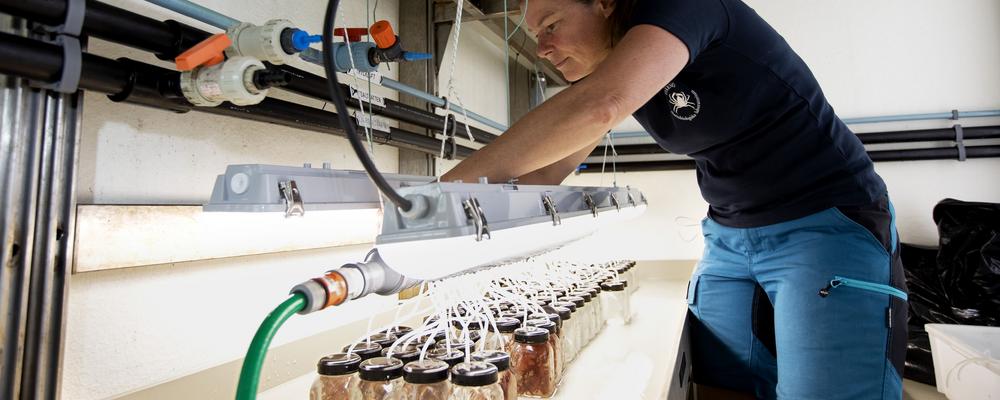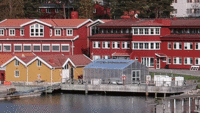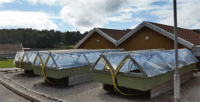
Laboratories
At the Tjärnö Laboratory there are several buildings and with plenty of laboratory spaces. The equipment is well suited to the education and research carried out at the field station.
Yellow Lab
- Deep and surface water
- 4 ”dry” lab benches, 2 m2 each
- 5 wet benches
- Inverted microscope (Olympus IX 71)
- Stereomicroscope (Olympus SZX 12)
- Camera that suits both microscopes
The purpose with Yellow Lab is working without hazardous chemicals.
Contact and booking
+46-31-786 96 15
The Ecotron
Deck with space for 3 troughs (5.7 metres long, 1.2 metres wide and 0.5 metre deep) and 10 troughs (1.0 metre long, 1.0 metre wide and 1.0 metre deep), equipped with flow-through deep and surface water (called mesocosms). Trough water depth is adjustable. With organisms in the troughs, experiments can be conducted in seminatural conditions. The advantage of The Ecotron is that you can manipulate external factors in a relatively ecologically realistic environment compared to laboratory conditions.

Contact and booking
+46-31-786 96 15
The Baltotron
Mesocosm aquarium system for the study of i.e. species from the Baltic. 6 troughs with sea water systems independent of each other. Each trough is divided in two, each half with a volume of approx. 860 litres. To the troughs there are deep and surface seawater as well as municipal tap fresh water. The Baltotron can be used with either recirculation or through-flow, with control of salinity and temperature. It is also possible to split the flow in order to increase replication. Underneath the troughs there is a drainage system, connected to either the sea or municipal sewage plant, depending on species studied. The Baltotron is approved by Swedish Board of Agriculture for work with fish, and can also be used for the study of alien species or populations.

Contact and booking
+46-31-786 96 15
Seaweed house
Floor area: 60 m2
Used for macroalgae aquaculture research, for development of blue biotechnology. Approx. 30 cultivations tanks, of 400 litre and 100 litre volume. Deep and surface water, of which one of them can be temperature regulated. Incoming water is filtered to 5 µm and treated with UV light. Air temperature regulation by automatic ventilation and heat pumps. Timer-regulated growth lamps and automated shade cloths. At the moment the Seaweed house is fully used by the Tjärnö aquaculture research group.
To the Tjärnö aquaculture research group there is also the working raft Algot 1. It is 8 metres long, 4 metres wide, has a generator which gives 360/220 V AC and a crane which lifts 500 kg, 2 metres from raft.

Contact Seaweed house
+46-31-786 96 04
The Seaweed house is available upon agreement with Göran Nylund or Gunilla Toth.
Contact Algot 1
FLUM/Hydrodynamic laboratory
Described equipment belongs to marine chemical ecology and biohydrodynamic group at the Department of Marine Sciences.
Larger flume tank with associated instruments: The flume tank is 6.5 metres long, 0.5 metre wide and 0.3 metre deep. The water (1200 litres) is recirculated through a pipe underneath the tank. The flow velocity can be regulated up to approx. 1 metre/sec and the velocity can be measured with a ADV (Acoustic Doppler Velocimeter, Nortek AS) in three dimensions at max 25 Hz. The walls of the flow tank are transparent and the water in the flume tank can be cooled to desired temperature. A laser based PIV/LIF system (LaVision with DaVis software) is installed by the flume tank. The PIV (Particle Image Velocimetry) system is measuring magnitude and direction of the flow in a two-dimensional plan with high spatial and temporal (max 15 Hz) resolution. With the LIF (Laser Induced Fluorescence) system, transport and dispersion of chemical substances in the water can be studied and spatial distribution of the substance in one dimension can be measured at max 15 Hz.
Smaller flume tank: The flume tank is 2 metres long, 0.2 metre wide and 0.1 metre deep. The tank with recirculating water holds 65 litres. Maximum flow velocity is 0.2 metre/sec.
Flow channel with flow-through water: The flume tank is 1.7 metres long, 0.3 metre wide and 0.15 metre deep. The water is continuously flowing through the channel and the outflow is tapered and has adjustable width. Maximum flow velocity is approx. 0.05 metre/sec.
ADCP for water current measurements in the field: ADCP (Acoustic Doppler Current Profiler, 1 MHz Nortek AS) measures water current velocity in three dimensions and at multiple levels in the water column. The extent of the measuring layers can be varied 0.3-4 metres and the maximum registered speed is 10 metres/sec. The range of the profiler is approximately 10-20 metres depending on the properties of water. Assembly equipment is available for measurement from bottom upwards or towards the bottom.
Contact
Top lab
Floor area 36 m2. No. 310A.
- Bench area for 6 persons
- Shelves with deep water
- Fume hood
- Local exhaust ventilation
- Particle Coulter Counter (Beckman). Responsible for equipment is Henrik Pavia. The equipment is currently in Gothenburg, and needs to be booked at least one week in advance.
- Fridge and freezer
Contact and booking
+46-31-786 96 15
Marine chemical ecology lab/Chemical lab
Equipped mainly for work in natural product chemistry, i.e.extraction and separation of secondary metabolites. Described equipment belongs to marine chemical ecology group at the Department of Marine Sciences.
HPLC lab:
- GC/MS (Agilents 8690 with MS 5973inert, and 100-position autosampler)
- LC-MS-QTOF (Agilents 6540) specialised towards metabolomics
- HPLC with RI-, DAD- and Fl-detector (Hitachi LaChrom from 2000)
Contact
RNA lab
Floor area 28 m2 (No. 105):
- Fume hood for isolation of RNA
- StepOnePlus real-time PCR (Applied biosystems)
- Fridge and freezer
Contact and booking
+46-31-786 96 15
Molecular biology lab
DNA lab, floor area 42 m2 (No. 104):
In this room tissue is prepared and DNA extraction is performed. There are 9 places of work.
- Fume hood
- Tempered centrifuge, 96-tube (Beckman Coulter, Allegra)
- Centrifuge for microtubes/8-strips (Eppendorf)
- Mini centrifuges
- Qubit Fluorometer (Invitrogen)
- Nanodrop ND-1000
- 3 dry block heaters
- Hot plate
- Bullet mixer-mill (Retsch)
- Scale
- Rotator SB3 (Stuart)
- Manual and electronic micropipettes
- Thermoshaker
- Ultra sonic cleaner
- Tempered water baths
- Vortex
- Fridge and freezer
- Ultra freezer (-86 °C)
PCR lab (No. 107):
- Gel electrophoresis equipment (2 containers)
- 4 PCR machines with temperature variable block (Veriti, Applied biosystems)
- 2 PCR:s (Eppendorf)
- Capillary electrophoresis machine Beckman Coulter CEQ8000
- Fume hood
- Fridge and freezer
- Separate working space (in fume hood) for RNA isolation
Contact and booking
+46-31-786 96 15
Described equipment belongs to the Department of Marine Sciences. Equipment is available upon agreement with Ahmed.
Microbiology lab/clean room
Floor area 21 m2. No. 108 & 109.
- 2 lab benches
- Security bench, class 2 – Thermo Scientific MSC-advantage
- Fume hood
- Shakers
- Heating cabinet
Histology lab
Floor area 21 m2. No. 106.
- Microtome och heating cabinet
- Fume hood
- Deep and surface water
Microscopy room / scale room
Floor area 12 m2. No. 112.
This room can be darkened.
- Olympus BX51
- Fluorescence microscope with camera
- Several stereo microscopes and light microscopes
- Five-decimal scale
Large course lab
Floor area 110 m2. No. 204.
- Space for 32 persons
- 24 stereo microscopes and 4 light microscopes
- Fume hood
- 2 chutes for holding live organisms, deep water
- Inverted microscope
- 42 inch screen, connectable to computer or microscope camera
- Shelves with deep and surface water
- Fridge and freezer
- Access to glass-ware, ice maker, distilled water, scales, filtration equipment, centrifuge, spectrophotometer, pH meter
Small course lab
Floor area 100 m2. No. 219.
- Space for 28 persons
- 16 stereo microscopes and 8 light microscopes
- Fume hood
- 2 chutes for holding live organisms, deep water
- Inverted microscope
- 42 inch screen, connectable to computer or microscope camera
- Shelves with deep and surface water
- Access to glass-ware, ice maker, distilled water, scales, filtration equipment, centrifuge, spectrophotometer, pH meter
Contact and booking
+46-31-786 96 15